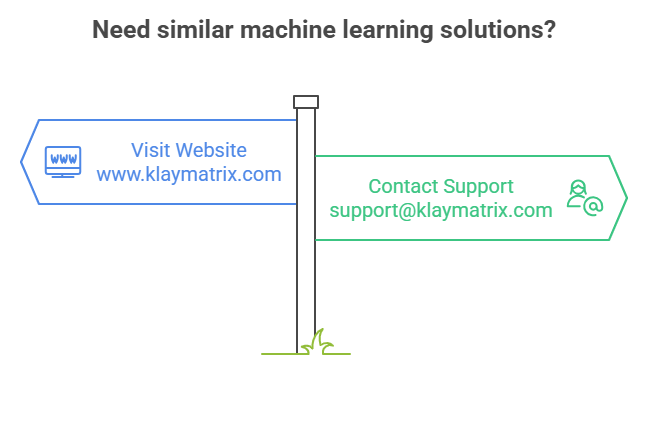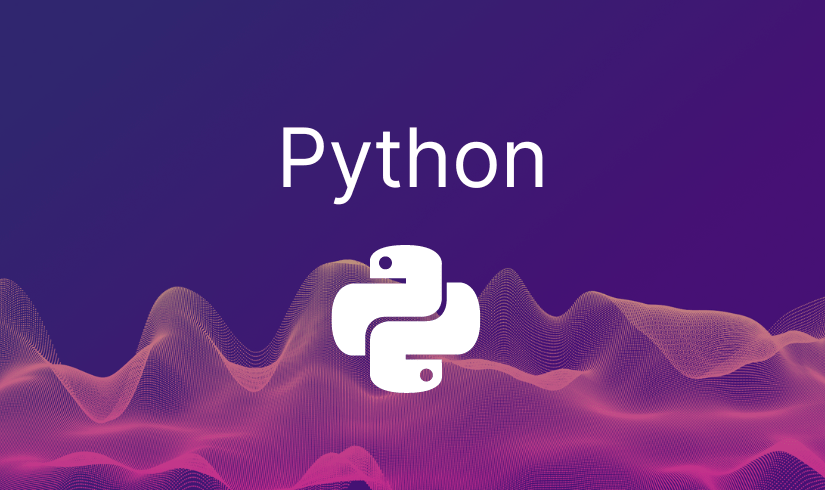Modern Data Architecture: A Beginner’s Guide to How Today’s Data Systems Work
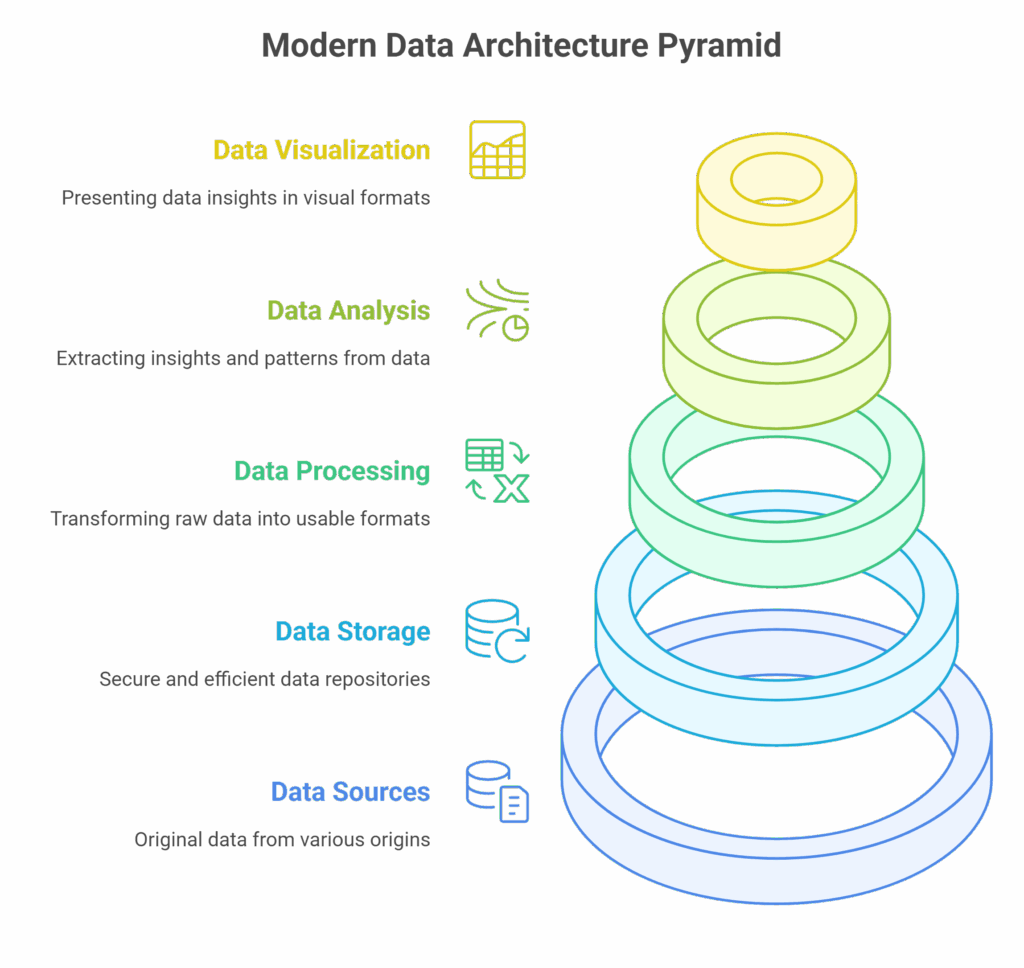
1. Introduction: What is Data Architecture?
In the digital age, every click, swipe, and transaction generates data. But raw data alone is not valuable until it is collected, stored, organized, and made ready for insights. That’s where data architecture comes in. Think of it as the blueprint that outlines how data flows through an organization—from the moment it’s generated to the point where it’s used for decisions.
Traditional data systems relied on siloed databases and structured data. But today, the landscape has changed dramatically. With the surge of unstructured data (emails, social media, IoT data), cloud technologies, and real-time analytics, we need a more flexible and scalable architecture: modern data architecture.
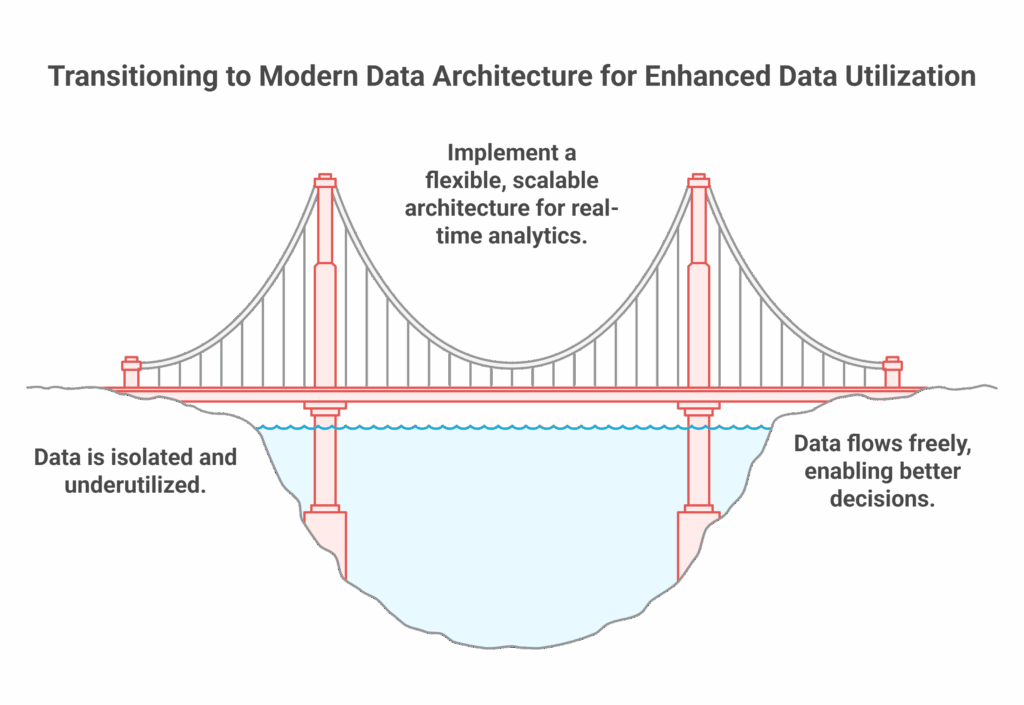
2. The Evolution of Data Architecture
Legacy Architecture:
Relied on on-premise servers
ETL processes into structured warehouses
Primarily batch processing
Modern Architecture:
Cloud-native platforms (e.g., Azure, AWS, GCP)
ELT processes for speed and flexibility
Data lakes for storing raw data
Real-time analytics capabilities
This shift supports the need for agility, scalability, and faster insights in a competitive world.

3. Core Components of Modern Data Architecture
3.1 Data Sources
These are the origins of your data. They can include:
Operational Databases: Store transactional data like customer orders, product inventory, or financial entries.
Flat Files: CSV, Excel, and JSON files exported from apps or systems; often used in manual processes.
APIs: Interfaces used to pull data from external systems such as social media, payment gateways, or SaaS tools.
Web & Mobile Apps: User activity, session logs, and usage statistics.
IoT Devices & Sensors: Real-time readings from machines, environments, or vehicles.
3.2 Ingestion Layer
The ingestion layer brings data into the ecosystem.
Batch Ingestion: Data collected at scheduled intervals; used when real-time access isn’t needed.
Streaming Ingestion: Real-time flow of data; ideal for dynamic systems like fraud detection.
Tools: Azure Data Factory, Kafka, Talend, Fivetran, Microsoft Fabric (with built-in Data Pipelines).
3.3 Storage Layer
Where data lives after ingestion:
Data Lakes: Cost-effective, scalable storage for raw data in any format (e.g., Azure Data Lake, Amazon S3).
Data Warehouses: Structured, cleaned data optimized for reporting (e.g., Azure Synapse, Snowflake).
Lakehouses: Combine lake flexibility with warehouse performance (e.g., Databricks).
Data Marts: Subject-specific slices of a warehouse for specific teams or departments.
3.4 Processing Layer
This layer transforms data into usable formats:
Batch Processing: Cleans and structures data on a schedule.
Real-time Processing: Immediate insights from streaming data.
Tools: Apache Spark, Azure Synapse, Azure Stream Analytics, Databricks.
3.5 Analytics & Visualization
Turns data into actionable insights:
Dashboards and Reports: Created using BI tools.
Self-service BI: Business users explore data independently.
Advanced Analytics: Machine learning or predictive modeling.
Tools: Power BI, Tableau, Looker.
3.6 Security & Governance
Ensures trust, compliance, and safety:
Data Governance: Roles, responsibilities, data definitions.
Security Measures: Encryption, access controls, audit logs.
Compliance: GDPR, HIPAA, CCPA, etc.
Data Catalogs & Lineage: Know where data came from and how it changed.
Tools: Microsoft Purview, Alation, Collibra.
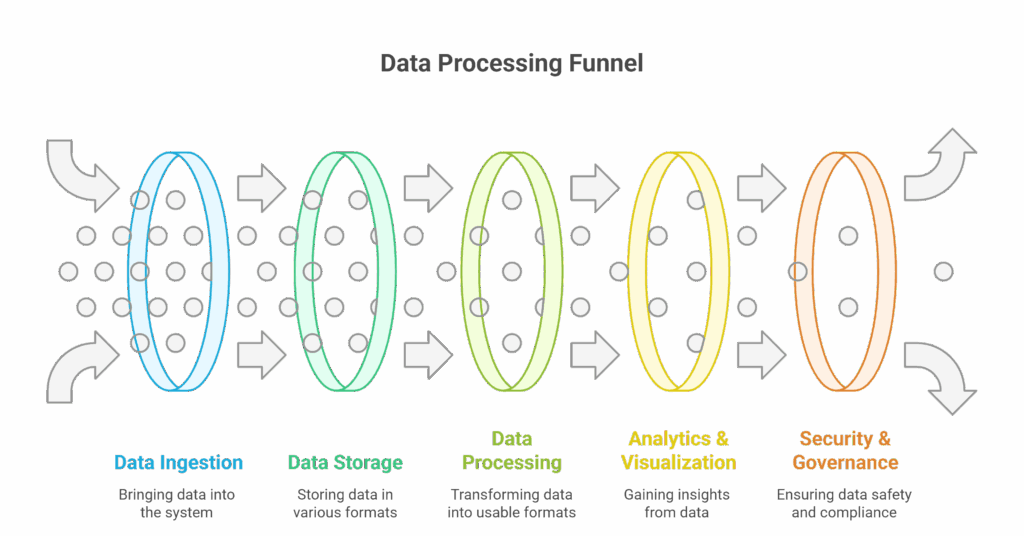
4. ETL vs. ELT: Understanding the Difference
ETL (Extract, Transform, Load):
Traditional method.
Data is first transformed in a staging area before being loaded to the warehouse.
Suitable for on-premise systems.
ELT (Extract, Load, Transform):
More modern approach.
Data is loaded first, then transformed within the target system.
Ideal for cloud platforms with scalable compute.

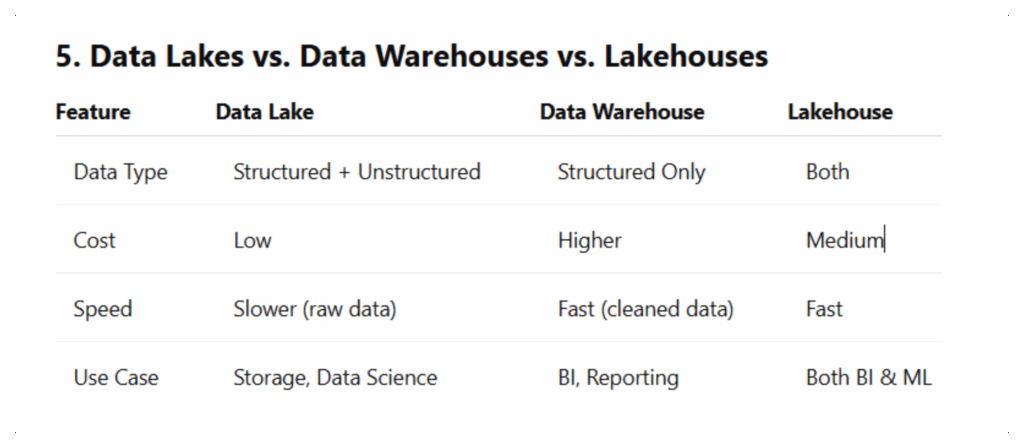
6. Real-time vs. Batch Processing
Batch Processing: Groups data and processes it at specific times.
Real-time Processing: Handles data as it arrives for immediate insight.
Example:
Retail: Batch for end-of-day sales reports; Real-time for inventory alerts.
Tools:
Batch: Azure Data Factory, Informatica
Real-time: Kafka, Azure Stream Analytics
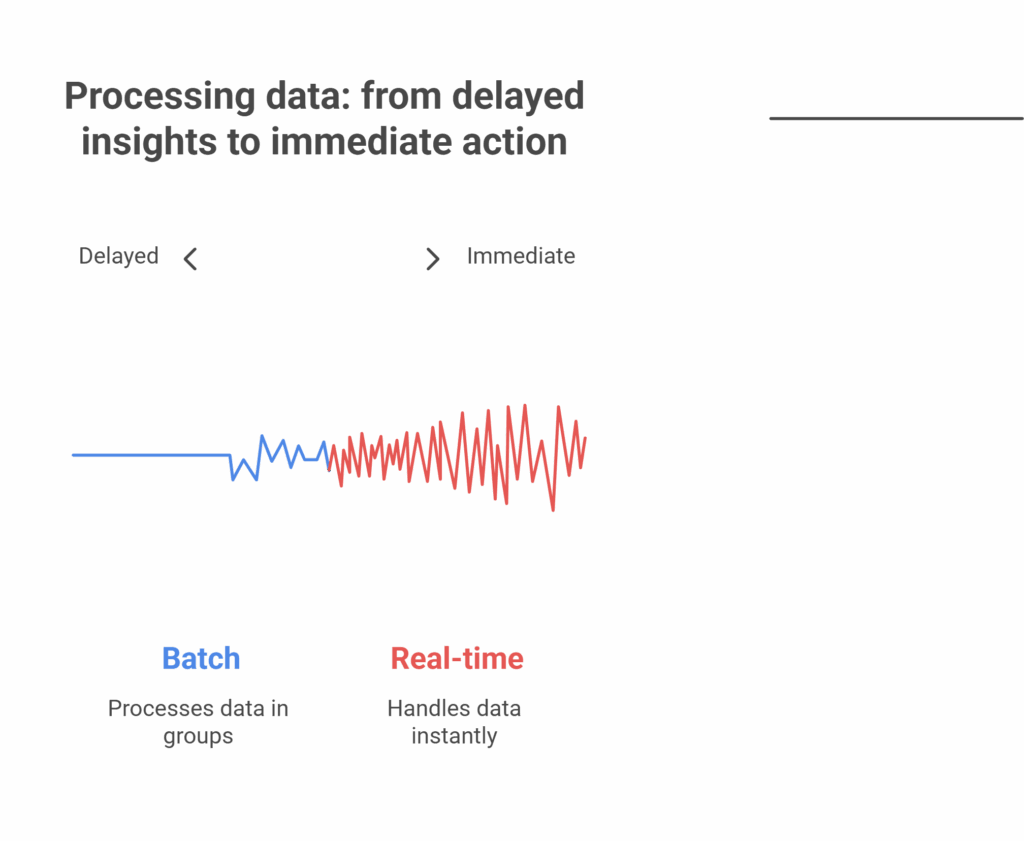
7. Popular Tools & Technologies
Cloud Platforms: Microsoft Azure, AWS, Google Cloud
Data Ingestion: Microsoft Fabric, Azure Data Factory, Airbyte
Processing Engines: Apache Spark, Databricks, Snowflake
Visualization: Power BI, Tableau, Google Looker
Governance: Microsoft Purview, Alation
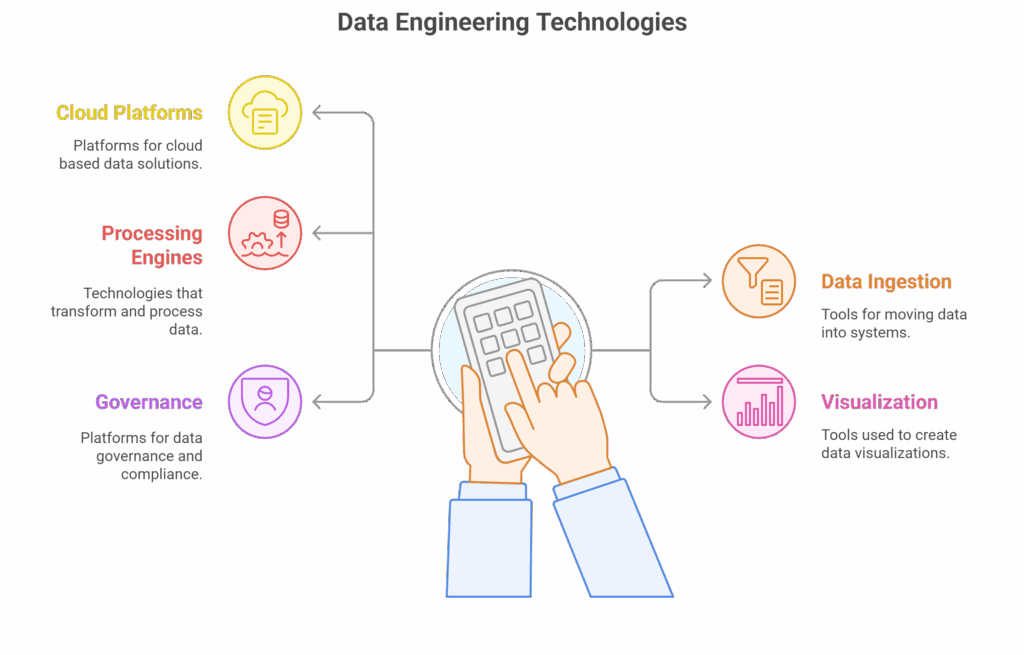
8. Security, Compliance, and Governance
Security and governance ensure responsible data use:
Authentication and Access: Secure who sees what.
Audit Logs: Track changes and access.
Compliance: Aligns with regulations like GDPR, CCPA, HIPAA.
Data Lineage: Understand how data flows and transforms.
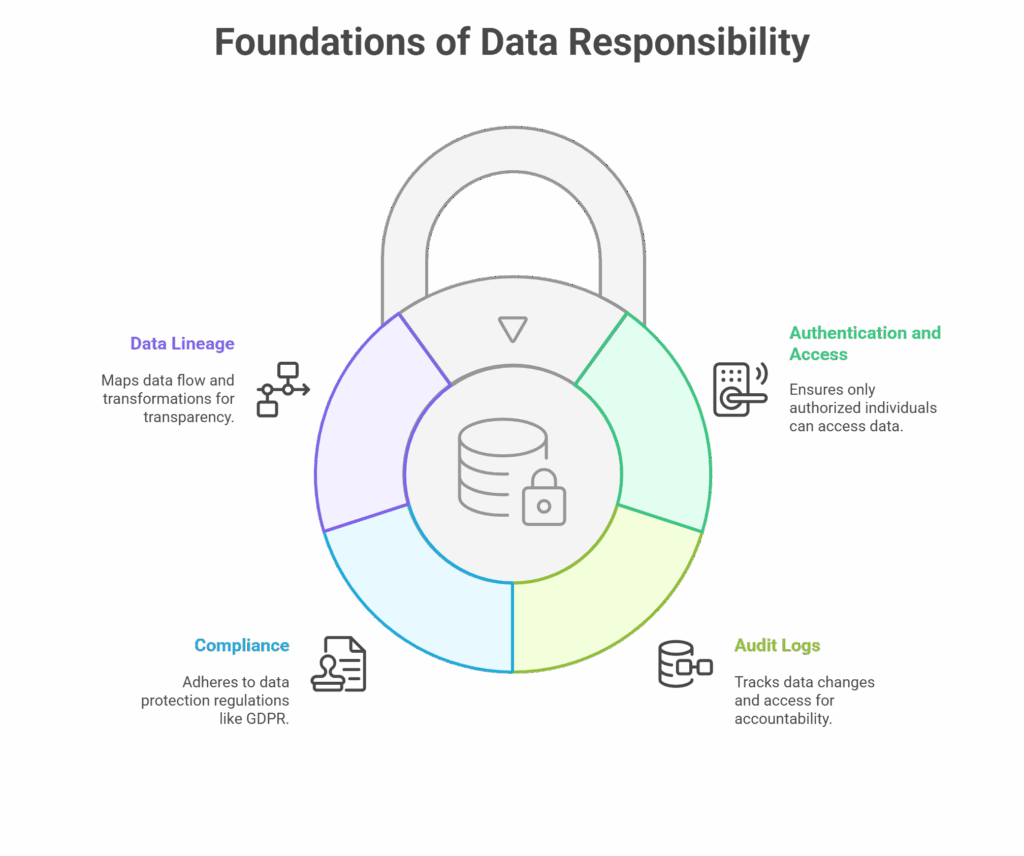
9. Benefits of a Well-Designed Architecture
Scalability: Add more data and users without disruption.
Agility: Rapid changes based on new business needs.
Collaboration: Break silos between teams.
Cost-efficiency: Optimized storage and compute in cloud.
10. Real-World Architecture Example: E-Commerce Business
Scenario: An online store tracks customer behavior, inventory, and orders.
Data Sources: Web clickstream, SQL database, third-party APIs (e.g., Stripe, Google Ads)
Ingestion: Azure Data Factory moves data from all sources
Storage: Raw data in Azure Data Lake; curated data in Synapse SQL Pool
Processing: Azure Synapse & Spark notebooks transform data
Visualization: Power BI dashboards for finance, marketing, and operations
Governance: Microsoft Purview handles lineage and data catalog
11. What’s Next in Data Architecture?
Data Mesh: Each domain owns and manages its data as a product.
AI-Native Platforms: Built with embedded ML and generative AI capabilities.
Low/No-Code Tools: Empower non-technical users to build pipelines.
Unified Suites like Microsoft Fabric: Bring all layers under one roof—ingestion, processing, storage, governance, and analytics.
12. Conclusion
Modern data architecture is the foundation for every data-driven organization. Understanding the key components—from flat files to real-time dashboards—empowers teams to make better, faster decisions. As businesses scale and data grows, having the right architecture ensures you’re not just collecting data, but truly using it to innovate.
